
Xirrus XR-1230 Series
2-slot radio 802.11n High Density Access Point with modular radios
Cambium Networks have acquired Xirrus! For the latest Xirrus' products please visit our Cambium Networks site.

Sorry, this product is no longer available. Please contact us for a replacement solution.
Overview:
The Xirrus XR-1000 Series Wireless Array is the first modular Wi-Fi product of its kind featuring upgradability, high scalability, high performance and integrated security to economically serve today’s requirements without sacrificing for tomorrow’s demand.
The Xirrus XR-1000 Wireless Array provides superior price/ performance value by integrating two multi-state (2.4GHz and 5GHz) modular APs with high gain directional antennas, wireless controller, multi-gigabit switch, firewall, threat sensor and spectrum analyzer into a single modular chassis. The XR-1000 is designed to meet requirements for wireless coverage in high RF attenuation environments (dense walls), low user/device density coverage, and designs that include isolated locations where reliable wireless coverage is desired.
The Xirrus XR-1000 Series 4-slot chassis is the industry’s only multi-state radio platform supporting multiple configurations with post-installation upgrade options. The Xirrus XR-1000 Series combines unmatched flexibility in wireless standards with the ability to scale a network to meet increasing demands without adding additional devices.
The XR-1000 utilizes the same multi-state modular APs available in all Xirrus XR Wireless Arrays, and is available in 300Mbps or 450Mbps 802.11n versions.
At A Glance
- 2 multi-state modular access points (2.4GHz and 5GHz)
- Supports 300Mbps or 450Mbps 802.11n versions
- Supports up to 480 users
- Field upgradable to new technologies (802.11ac, 802.11ad)
NSP Architecture for Amazing Performance
The architecture of the Xirrus XR-1000 Array is based upon a Network Services Processor (NSP) that delivers uncompromised performance to all associated users. The design allows for hardware based encryption, compression, acceleration, as well as reliable quality of service with uptimes and availability optimized for 802.11n performance and scalability.
Unmatched Upgradability
The Xirrus XR-1000 radio upgradable wireless platform allows a network to upgrade technologies without full replacement of the Array. Modular APs can be purchased in 300Mbps or 450Mbps versions, and every modular AP is capable of operating at 2.4GHz and 5GHz. The modular platform ensures support for new wireless technologies and is the first 802.11ac/11ad-ready product available.
New Features
Application Control – Firewall, apply QoS, and manage 900+ application types under 15 categories using Layer 7 Deep Packet Inspection and other contextual application detection techniques.
Bonjour Director – Extend Apple Bonjour protocols across Layer 3 boundaries for simple setup configuration of commonly used shared Apple services such as Airplay and Airprint.
Benefits:
Unprecendented Wi-Fi Capacity
With dual core to 6 core processors and 2-16 radio platforms, Xirrus High Density Access Points meet the unprecedented demands for high performance and high capacity Wi-Fi networks in today's connected environment.
Extend the Life of Your Wi-Fi Network
Xirrus High Density APs are built on a modular architecture that sustains multiple generations of technologies without a need to replace infrastructure and extends the life of your Wi-Fi network.
Superior Wi-Fi User Experience
Every High Density Access Point with integrated controller and distributed intelligence, eliminates the need for a centralized controller and automatically adapts based to device capabilities for a superior user experience.
Complete Application Visibility and Control in Every AP
Xirrus delivers holistic application visibility based on Deep Packet Inspection (DPI) technology and provides predictable application performance by controlling up to 1,300 applications at the network edge. Applications or groups of applications can be allowed, blocked or throttled and policies can be schedule by device or across the network at specified times of day or days of week.
Automated Performance Optimization
Xirrus optimizes the network performance with Auto RF configurations. Xirrus High Density Access Points automatically choose the best available channel, band and power level without IT intervention. Xirrus High Density APs also customize user connectivity for the best performance based on each device capability.
Bonjour and Guest Services
Xirrus High Density Access Points include Bonjour Director, which allows easy access for Apple devices to access Apple services from across the network, and Guest Access, which provides secure access to guests via self-provisioning with optional sponsor workflow or through a non-IT guest ambassador. Guests can also use social media credentials to login or receive passwords by SMS or email.
Flexible
The XR-1000 adds greater deployment flexibility for Xirrus XR-Series Wireless Array network designs. Engineers have greater flexibility in Array placement to maximize coverage and minimize equipment costs.
Scalable
Maintain a high level of performance for mission-critical applications and support the ability to handle unpredictable user growth throughout your wireless network. Scale capacity by increasing the network traffic throughput without installing additional devices.
Secure
Eliminate potential gaps in security infrastructure with the XR-1000 series virtualized firewall, threat sensor and spectrum analyzer providing comprehensive security without the need for additional equipment.
Economical
Multi-state design (2.4GHz and 5GHz on both modular APs) enables significant flexibility in adapting the wireless network to usage changes over time as compared to traditional APs which are fixed by band per radio. Modular AP slots enable upgrades to new radio technology over time without complete replace- ment of the product.
Specifications:
| Configuration Specifications | ||
|---|---|---|
| XR-1220 | XR-1230 | |
| Chassis Size | 7” | 7” |
| AP Slots | 2 | 2 |
| Populated 802.11n Radios | 2 | 2 |
| Maximum Wi-Fi Bandwidth | 600Mbps | 900Mbps |
| Dedicated Wi-Fi Threat Sensor | Yes | Yes |
| Integrated Antennas | 4 | 6 |
| Maximum Wi-Fi Backhaul | 450Mbps | 450Mbps |
| Integrated Switch Ports | 2 | 2 |
| Gigabit Ethernet Uplink Ports | 1 | 1 |
| Maximum Associated Users | 480 | 480 |
| Radio Interface | 2.5Gbps PCI-Express | 2.5Gbps PCI-Express |
| Maximum Power Consumption | 19W | 22W |
| Maximum Power Consumption | 33W | 38W |
| Technical Specifications | ||
| Feature | Specifications | |
| RF Management | In-band per IAP Spectrum Analysis Dynamic channel configuration Dynamic cell size configuration Monitor radio for threat assessment and mitigation Wired and wireless packet captures (including all 802.11 headers) Wired and Wireless Packet Captures Radio assurance for radio self test and healing RF monitor 2.4 & 5.0Ghz Honeypot Control – Increase available 2.4 & 5.0Ghz wireless device density through management of spurious 2.4 & 5.0Ghz association traffic. Ultra Low Power Mode – Maximize wireless channel re-use and increase wireless device density through tight power controls. |
|
| Wireless Protocols | IEEE 802.11a, 802.11b, 802.11d, 802.11e, 802.11g, 802.11h, 802.11i, 802.11j, 802.11n | |
| Wired Protocols | IEEE 802.3 10BASE-T, IEEE 802.3.u 100BASE-TX, 1000BASE-T, 802.3ab 1000BASE-T IEEE 802.1q – VLAN tagging IEEE 802.1AX – Link aggregation IEEE 802.1d – Spanning tree IEEE 802.1p – Layer 2 traffic prioritization IPv6 Control – Increase wireless device density through control of unnecessary IPv6 traffic on IPv4-only networks. |
|
| Channel Support 2.4GHz (channels available based on country code selected) |
1 2 3 4 5 6 7 8 9 10 11 12 13 14 | |
| Channel Support 5GHz (channels available based on country code selected) |
WPA IEEE 802.11i WPA2, RSN RFC 1321 MD5 Message-digest algorithm RFC 2246 TLS protocol version 1.0 RFC 3280 Internet X.509 PKI certificate and CRL profile RFC 4347 Datagram transport layer security RFC 4346 TLS protocol version 1.1 |
|
| Management Interfaces | Command line interface Web interface (http / https) Xirrus Management System (XMS) |
|
| Management | SNMP v1, v2c, v3 RFC 854 Telnet RFC 1155 Management Information for TCP/IP Based Internets RFC 1156 MIB RFC 1157 SNMP RFC 1212 Concise MIB Definitions RFC 1213 SNMP MIB II RFC 1215 A Convention for Defining Traps for use with the SNMP RFC 1350 TFTP RFC 1643 Ethernet MIB RFC 2030 Simple Network Time Protocol SNTP RFC 2578 Structure of Management Information Version 2 (SMIv2) RFC 2579 Textual Conventions for SMIv2 RFC 2616 HTTP 1.1 RFC 2665 Definitions of Managed Objects for the Ethernet Like Interface Types RFC 2674 Definitions of Managed Objects for Bridges with Traffic Classes, Multicast Filtering and Virtual LAN Extensions RFC 2863 The Interface Group MIB RFC 3164 BSD Syslog Protocol RFC 3414 User-based Security Model (USM) for version 3 of the Simple Network Management Protocol (SNMPv3) RFC 3416 Version 2 of the Protocol Operations for the Simple Network Management Protocol (SNMP) RFC 3417 Transport Mappings for the Simple Network Management Protocol (SNMP) RFC 3418 Management Information Base (MIB) for the Simple Network RFC 3584 Coexistence between Version 1, Version 2, and Version 3 of the Internet-standard Network Management Framework RFC 3636 Definitions of Managed Objects for IEEE Xirrus Private MIBs Integration with Splunk for accurate search and analysis of intra-organizational IT events Netflow Export v9 and IPFIX compatibility allows for IP traffic statistics collection |
|
| Carrier Applications | Passport Certification | |
| RFC Support | RFC 768 UDP RFC 791 IP RFC 2460 IPV6 (Bridging only) RFC 792 ICMP RFC 793 TCP RFC 826 ARP RFC 1122 Requirements for internet hosts – communication layers RFC 1542 BOOTP |
|
| Security | WPA IEEE 802.11i WPA2, RSN RFC 1321 MD5 Message-digest algorithm RFC 2246 TLS protocol version 1.0 RFC 3280 Internet X.509 PKI certificate and CRL profile RFC 4347 Datagram transport layer security RFC 4346 TLS protocol version 1.1 |
|
| Encryption Types | Open, WEP, TKIP-MIC: RC4 40, 104 and 128 bits SSL and TLS: RC4 128-bit and RDA 1024 and 2048 bit modular AP |
|
| Authentication | IEEE 802.1x RFC 2548 Microsoft vendor-specific RADIUS attributes RFC 2716 PPP EAP-TLS RFC 2865 RADIUS Authentication RFC 2866 RADIUS Accounting RFC 2867 Tunnel Accounting RFC 2869 RADIUS Extensions RFC 3576 Dynamic Authorizations extensions to RADIUS RFC 3579 RADIUS Support for EAP RFC 3748 EAP-PEAP RFC 5216 EAP-TLS RFC 5281 EAP-TTLS RFC 2284 EAP-GTC RFC 4186 EAP-SIM RFC 3748 Leap Pass through RFC 3748 Extensible Authentication Protocol Web Page Authentication WPR, Landing Page, Redirect Support for Internal WPR, Landing Page and Authentication Support for External WPR, Landing Page and Authentication |
|
| Regulatory Compliance | CE Mark Safety: UL 60950-1:2003 EN 60950:2000 EMI and susceptibility (Class A) U.S.:FCC Part 15.107 and 15.109 Canada: ICES-003 Europe: EN 55022, EN 55024 EN 60601-1-2 EN 301 893 V1.6.1 |
|
| Physical Specifications | Dimensions (no connectors): 2.75 x 7.75 x 7.75 in. Weight: 1.3lb |
|
| Environmental Specifications | Operating Temperature: 0 to +55C, 0-90% humidity, non-condensing |
|
Receive Sensitivity:
| XR Receive Sensitivity | ||||||||
|---|---|---|---|---|---|---|---|---|
| 802.11a | 802.11b | 802.11g | ||||||
| Data Rate | RX Sensitivity (DBM) | Data Rate | RX Sensitivity (DBM) | Data Rate | RX Sensitivity (DBM) | |||
| 2.4GHz | 5GHz | 2.4GHz | 5GHz | 2.4GHz | 5GHz | |||
| 6Mbps | -92 | 1Mbps | -91 | 6Mbps | -93 | |||
| 9Mbps | -92 | 2Mbps | -91 | 9Mbps | -93 | |||
| 12Mbps | -91 | 5.5Mbps | -93 | 12Mbps | -92 | |||
| 18Mbps | -90 | 11Mbps | -93 | 18Mbps | -91 | |||
| 24Mbps | -87 | 24Mbps | -90 | |||||
| 36Mbps | -83 | 36Mbps | -88 | |||||
| 48Mbps | -79 | 48Mbps | -83 | |||||
| 54Mbps | -78 | 54Mbps | -80 | |||||
| 802.11n HT20 | 802.11n HT40 | ||||
| Data Rate | RX Sensitivity (DBM) | Data Rate | RX Sensitivity (DBM) | ||
| 2.4GHz | 5GHz | 2.4GHz | 5GHz | ||
| MCS 0 | -93 | -93 | MCS 0 | -93 | -91 |
| MCS 1 | -93 | -92 | MCS 1 | -92 | -88 |
| MCS 2 | -92 | -88 | MCS 2 | -90 | -86 |
| MCS 3 | -88 | -85 | MCS 3 | -87 | -83 |
| MCS 4 | -86 | -81 | MCS 4 | -84 | -79 |
| MCS 5 | -82 | -77 | MCS 5 | -80 | -75 |
| MCS 6 | -80 | -76 | MCS 6 | -78 | -74 |
| MCS 7 | -79 | -75 | MCS 7 | -77 | -73 |
| MCS 8 | -95 | -93 | MCS 8 | -92 | -90 |
| MCS 9 | -92 | -90 | MCS 9 | -89 | -87 |
| MCS 10 | -89 | -88 | MCS 10 | -87 | -85 |
| MCS 11 | -87 | -85 | MCS 11 | -84 | -82 |
| MCS 12 | -83 | -81 | MCS 12 | -81 | -78 |
| MCS 13 | -79 | -77 | MCS 13 | -77 | -74 |
| MCS 14 | -78 | -76 | MCS 14 | -75 | -73 |
| MCS 15 | -76 | -75 | MCS 15 | -74 | -72 |
| MCS 16 | -92 | -93 | MCS 16 | -91 | -90 |
| MCS 17 | -91 | -90 | MCS 17 | -88 | -87 |
| MCS 18 | -89 | -88 | MCS 18 | -86 | -85 |
| MCS 19 | -86 | -85 | MCS 19 | -83 | -82 |
| MCS 20 | -82 | -81 | MCS 20 | -79 | -78 |
| MCS 21 | -78 | -77 | MCS 21 | -75 | -74 |
| MCS 22 | -77 | -76 | MCS 22 | -74 | -73 |
| MCS 23 | -76 | -75 | MCS 23 | -73 | -72 |
| 802.11ac VHT20 | 802.11ac VHT40 | 802.11ac VHT80 | ||||||
| Data Rate | RX Sensitivity (DBM) | Data Rate | RX Sensitivity (DBM) | Data Rate | RX Sensitivity (DBM) | |||
| 2.4GHz | 5GHz | 2.4GHz | 5GHz | 2.4GHz | 5GHz | |||
| MCS 0 | -82 | MCS 0 | -88 | MCS 0 | -86 | |||
| MCS 1 | -79 | MCS 1 | -85 | MCS 1 | -83 | |||
| MCS 2 | -77 | MCS 2 | -83 | MCS 2 | -81 | |||
| MCS 3 | -74 | MCS 3 | -80 | MCS 3 | -78 | |||
| MCS 4 | -70 | MCS 4 | -76 | MCS 4 | -74 | |||
| MCS 5 | -66 | MCS 5 | -72 | MCS 5 | -70 | |||
| MCS 6 | -65 | MCS 6 | -71 | MCS 6 | -69 | |||
| MCS 7 | -64 | MCS 7 | -69 | MCS 7 | -68 | |||
| MCS 8 | -59 | MCS 8 | -67 | MCS 8 | -66 | |||
| MCS 9 | -57 | MCS 9 | -66 | MCS 9 | -64 | |||
Xirrus Architecture:
Designed for Scalable Networks
The conventional method of deploying thin access points tied to central controllers is breaking down under the load of BYOD and mobile applications. Exacerbating the issue are new wireless standards, such as 802.11ac, that can deliver 3-5 times or more than that of 802.11n speeds. Xirrus addresses these scalability challenges with architectural innovations including:
Xirrus Architectural components
- Distributed intelligence with integrated controllers
- Software programmable radios
- Modular design to future proof the network
- Multi-radio platform for increasing density needs
- Directional antennas for greater coverage and RF control
Distributed Intelligence with Integrated Controllers
Xirrus integrates the controller function and application-level visibility control into each AP/ High-Density APs to distribute the intelligence. Distributed intelligence eliminates the single point of failure and potential performance bottlenecks of a controller. Benefits of Integrated controller include:
- Linear Scalability
- Efficient Policy Enforcement
- High resiliency
- Superior network performance
Software Programmable Radios
Future proof Xirrus wireless network with software programmable radios. As mobile devices continue to support 5GHz band, the radios in Xirrus platforms can be configured to simultaneously operate in 5GHz band.
Modular Design
Xirrus High-Density APs built for modularity, support swappable radio modules. As technology changes, the Xirrus networks can easily support newer technology without having to rip and replace the APs there by extending the life of your investment.
Directional Antennas
The sectored antenna design of the High-Density APs provides a superior RF control and can be more optimally managed for channel allocation, interference mitigation and user performance management. This directional antenna creates greater separation between radios and reduces interfering.
Multi-radio Platform
Wi-Fi being a shared medium requires greater number of radios to support the proliferation of devices. Xirrus APs can support from 2-16 radios in a single platform providing more radios for higher performance. The High-Density APs allow you to:
- Easily increase Wi-Fi capacity
- Optimize RF coverage pattern
- Simplify technology transition (Simultaneously support 802.11ac wave 1, wave 2)
The flexibility provided by the Wireless High-Density Access Point enables capacity planning without replacement of the chassis itself. This ensures a long, 10-year product lifespan that is adaptive to your business requirements and protects your investment against inevitable increasing capacity demands.
Core Technology:
Wireless that is 4X better.
Organizations depend on high-bandwidth for voice, video, and data to and from mobile devices. Today, more than ever, you need high-performance wireless. We deliver it. Our wireless solutions provide wired-like reliability, superior security, and they perform under the most demanding conditions.
The Xirrus Way

Let's face it, the conventional method of deploying thin APs tied to central controllers are failing under the load of 802.11n and will completely collapse with the introduction 802.11ac and 802.11ad. Like the switching market learned some time ago, it's ridiculous to force all network traffic into a single box. This creates traffic jams and single points of failure.
The Other Way
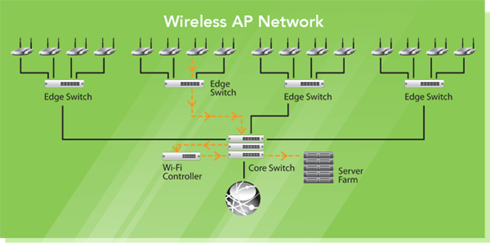
The best way to deploy wireless is with a distributed architecture with multiple radios and directional antennas per cable drop. This is how the cellular industry solved capacity issues in the late 1990's. By placing more radios into each cell tower, they gained created capacity and coverage per location. This enabled the industry to keep up with demand while saving them enormous amounts of cash.
So that's what we did. Our distributed, multi-AP solution is the most powerful, scalable, and trusted wireless platform in the industry. It's easier to deploy. Is more cost effective. And can grow as performance and capacity change.
Dense modular APs
Conventional APs contain two radios. The wireless bandwidth available on these radios is shared amongst all devices. The more devices, the less bandwidth available to each device.
To ensure sufficient bandwidth, more radios are required. You can either add more two-radio APs or you can add more radios per AP. We chose the better approach. Incorporating 2 to 16 modular APs per Array, we get much greater bandwidth to service more devices. We also get significant savings in the number of APs, cable drops, switch ports, and labor costs.
Directional antennas
Fact of the matter is national communications agencies limit the amount of energy a radio can transmit, which restricts the coverage area of that radio. Conventional APs utilize Omni-directional antennas to transmit its wireless signal in a 360-degree pattern – similar to a light bulb – limiting the coverage area.
Wireless Arrays are better in that they focus that same amount energy in a specific direction – similar to a flashlight – giving a much greater distance than those conventional APs. Again, this results in far fewer APs per deployment – typically by 75%.

Distributed intelligence
Traditional wireless architectures consist of thin APs connected to a central controller. The controller resides in the backend of the network and performs control, security and management functions for multiple (often hundreds) of APs. The three biggest issues with this approach are traffic congestion, single point of failure, and unencrypted data from the AP to the controller.
Our approach integrates the controller function into the Wireless Array to distribute the intelligence, much like wired edge switches. By distributing the network, you get better performance and encryption all the way out to the edge. What's more, our approach simplifies the deployment, making it more flexible and cost effective.
What does it mean to you
There are numerous advantages to our approach:
- Designed for pervasive enterprise coverage, not just hotspots
- Designed for density of BYOD, not just 10 people in a conference room
- Designed for multi-media and critical applications, not just email and web browsing
- Designed to be adaptive and upgraded as requirements grow, not replaced as technology changes
- Designed to lower total cost of ownership by requiring less equipment and infrastructure, not more
Key Technologies
Our Wireless Array platform enables far superior functionality, capacity, and upgradability not possible with conventional AP offerings. We make it possible for your workforce to communicate when and where is optimal for them and your customers. By improving communications, you improve productivity and profitability.
The following critical technologies make it possible to meet the rapidly evolving requirements for a robust wireless network:
- Modular AP system
- Integrated controller
- Multi-sector antenna system
- Dedicated security monitoring
- Dedicated wireless backhaul
- Radio optimization management
- Resource assurance management
- Device optimization management
The exploding growth of tablets and smartphones is constricting today's wireless networks. Mandating infrastructure upgrades. Normal approach has been to add more and more APs to grow capacity, but this means costly network changes.
Integrated controller
We have integrated the controller functionality into each Wireless Array. We provide a host of functions, including high performance packet processing, networking, security processing, RF control, RF monitoring, inter-Array coordination and network management.
By placing the intelligence and packet processing at the network edge, you will gain several benefits, including:
- Linear scalability – Capacity is incrementally added to the network by simply adding Arrays, as opposed to adding entirely new, expensive controllers when their AP limit is reached
- Policy enforcement – With intelligence and processing distributed in each Array, security and performance policies can be applied with greater efficiency directly at the network edge as opposed to centrally
- Easier installation – With autonomous operation, Arrays integrate to the network infrastructure similar to a switch as opposed to a thin AP which is dependent on the connection to a central controller
- High resiliency – Each Array operates as a standalone device with no dependency or single point of failure from a central controller
- Superior network performance – By processing control and data traffic at the network edge as opposed a centralized location, traffic latency, jitter, and roaming times are reduced and better controlled
 Multi-sector antenna system
Multi-sector antenna system
The sectored antenna design of the Wireless Array provides a superior level of RF control within the system compared to traditional wireless solutions. RF resources can be more optimally managed with this design compared to conventional Omni-directional antenna systems in areas of channel allocation, interference mitigation, and user performance.
A sectored antenna system creates slices of wireless coverage. Each slice uses a unique channel and clusters devices. This approach creates greater physical separation between sectors and devices on a given channel as opposed to Omni-directional antennas that transmit RF in all directions. Directionality of the sectors isolates radios on adjacent Arrays from interfering with each other. This together with appropriate channel design allows the reuse of the same channels by adjacent Wireless Arrays. Channel reuse is critical for a wireless network to operate at high capacity since only a limited number of channels are available, in particular with only three non-overlapping channels in the 2.4GHz band.
With our approach, you get higher RF gain. It transmits stronger signals to the wireless clients and correspondingly receives weaker signals from them since antenna gain works in both directions. Stronger signal provides better communication data rates for a client at given distance, as well as better operational range.
Dedicated security monitoring
Another costly network component found in conventional offerings are security monitors. Unlike the competition, we have integrated a wireless threat sensor into each Wireless Array, making it possible to have a dense design without compromising radio resources for servicing users.
Most offerings are restricted since both radios in the AP are typically required for servicing users – one operating at 2.4GHz and one at 5GHz. To perform security-monitoring functions, additional APs must be added to the network or one of the two radios must time-slice between servicing users and performing security functions. Time-slicing reduces the bandwidth available to servicing users and is significantly less efficient performing scanning functions as opposed to a dedicated radio resource.
By default, a dedicated monitoring radio in our Wireless Arrays continually scans the RF environment 24x7 covering all Wi-Fi channels in about 10 seconds. When called upon, it can perform additional functions focused on a given channel or threat as required. These functions do not interrupt the servicing of user traffic on the Array in any way.
Functions of the Array's monitor radio include:
- Wireless threat/attack detection for wireless IDS/IPS (Intrusion Detection/Intrusion Prevention)
- Rogue AP and ad hoc station detection, classification, and mitigation
- Spectrum analysis providing performance, interference, and error information across all Wi-Fi channels
- Wireless packet capture on any Wi-Fi channel
- Proactive self-monitoring by functioning as a wireless client connecting to other radios in the Array
Dedicated wireless backhaul
The multi-radio design of the Wireless Array enables radios to be configured as a dedicated wireless backbone between Arrays. This functionality is referred to as Wireless Distribution System (WDS).
WDS eliminates the need to run wired uplinks to Arrays in areas where it may be impractical or cost-prohibitive to pull cable. All security and network policies are enforced across the backhaul links, the same as if the Arrays are connected via wired uplinks. Radio bonding allows multiple backhaul links to be aggregated, providing load balancing of traffic and fail-over capabilities for a uniform and fault-tolerant deployment.
With multiple radios available per Array, wireless backhaul can be configured on radios independent of those servicing users. Traditional enterprise APs with two radios are limited to one radio for a backhaul (mesh) connection. This radio must share the same channel as all other APs on that mesh link, severely limiting the total amount of bandwidth available for backhaul. With the Xirrus Array, backhaul connections are dedicated point-to-point links between Arrays and operate without performance compromise.
We can create up to four independent wireless backhaul links per Array and bond up to three radios together in for each link. Using 450Mbps 802.11n radios, each backhaul can offer up to 1.35Gbps of total Wi-Fi bandwidth. The connections support 802.1d Spanning tree bridging services for failover and link redundancy, including with the Array's wired interfaces.
Radio optimization
The multi-radio and directional antenna design of our Wireless Arrays provide significantly greater control of RF design and management compared to traditional APs. All radio resources can be individually controlled for band selection (2.4GHz or 5GHz), transmit power, and channel allocation. Control can be done either automatically or manually.
Resource assurance
The distributed design of the Array provides a level of processing power and intelligence not available in traditional thin AP designs where much of the resources reside in a centralized controller. By placing these resources at the network edge, the Array can apply proactive and pre-emptive monitoring of operational resources to detect and respond to issues when they occur.
Device optimization
The multi-radio architecture of the Array provides a high level of flexibility in allocating Wi-Fi users and devices among system resources to optimize overall performance. As wireless is a shared communications medium, clients on a given radio resource affect the performance of others using the same resource.
Array Chassis:
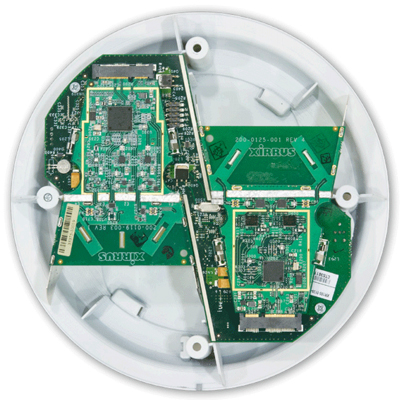
XR-1000 Series 2-Slot Chassis
Shown configured with two multi-state, pluggable radio modules
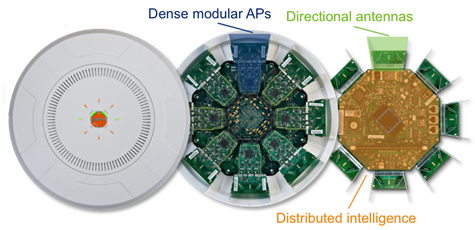 Architectural Components
Architectural Components
There are three primary components in the Wireless Array
- Dense modular APs
- Directional antennas
- Distributed intelligence
The better method for growing capacity was solved by the wired switching industry by using chassis with modular blades. Our modular AP platform provides a unique and exceptional value. It can adapt to meet new requirements as your needs change. The Wireless Arrays allow you to:
Add radios to an Array chassis to increase capacity
- Reposition radios within a chassis to optimize RF coverage pattern
- Migrate radios and users from 2.4GHz to higher performing 5GHz band when ready (all radios are multi-band)
- Swap radios to higher performing wireless technology as available (802.11ac and 802.11ad standard)
 8 Modular AP Radios for XR-4000 Series |
 8, 12 or 16 Modular AP Radios for XR-6000 Series |
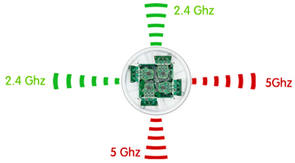 |
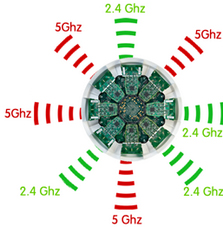 |
The flexibility provided by the Wireless Array enables capacity planning without replacement of the Array chassis itself. This ensures a long product lifespan (5+ years) that is adaptive to your business requirements and protects your investment against inevitable increasing capacity demands.
Eight Access Point XR Under the Hood (Depopulates to 4 Access Point Array)
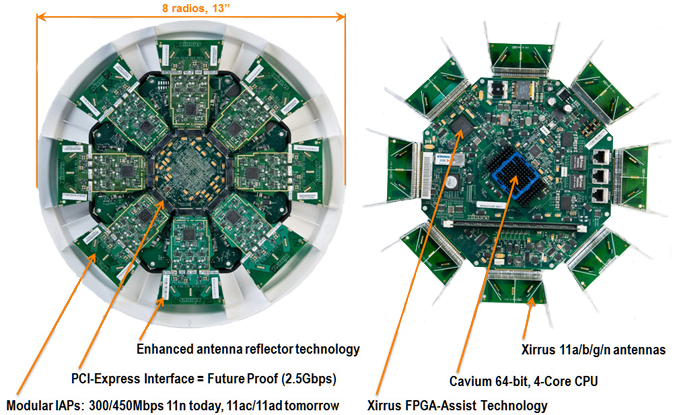
Documentation:
Download the Xirrus XR-1000 Series Datasheet (PDF).
Pricing Notes:
- Pricing and product availability subject to change without notice.
Our Price: $20.00
Our Price: $48.00
Our Price: $25.00
Our Price: $70.00
Our Price: $120.00
Our Price: $375.00
Our Price: $80.00
